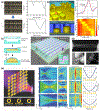Recent Advances in Liquid Metal Photonics: Technologies and Applications
- PMID: 38249122
- PMCID: PMC10798671
- DOI: 10.1364/ome.484236
Recent Advances in Liquid Metal Photonics: Technologies and Applications
Abstract
Near-room-temperature liquid metals offer unique and crucial advantages over solid metals for a broad range of applications which require soft, stretchable and/or reconfigurable structures and devices. In particular, gallium-based liquid metals are the most suitable for a wide range of applications, not only owing to their low melting points, but also thanks to their low toxicity and negligible vapor pressure. In addition, gallium-based liquid metals exhibit attractive optical properties which make them highly suitable for a variety of photonics applications. This review summarizes the material properties of gallium-based liquid metals, highlights several effective techniques for fabricating liquid-metal-based structures and devices, and then focuses on the various photonics applications of these liquid metals in different spectral regions, following with a discussion on the challenges and opportunities for future research in this relatively nascent field.
Conflict of interest statement
Disclosures. The authors declare no conflicts of interest.
Figures









Similar articles
-
Emerging applications of liquid metals featuring surface oxides.ACS Appl Mater Interfaces. 2014 Nov 12;6(21):18369-79. doi: 10.1021/am5043017. Epub 2014 Oct 6. ACS Appl Mater Interfaces. 2014. PMID: 25283244 Free PMC article.
-
Stretchable and Soft Electronics using Liquid Metals.Adv Mater. 2017 Jul;29(27). doi: 10.1002/adma.201606425. Epub 2017 Apr 18. Adv Mater. 2017. PMID: 28417536 Review.
-
Attributes, Fabrication, and Applications of Gallium-Based Liquid Metal Particles.Adv Sci (Weinh). 2020 Apr 22;7(12):2000192. doi: 10.1002/advs.202000192. eCollection 2020 Jun. Adv Sci (Weinh). 2020. PMID: 32596120 Free PMC article. Review.
-
Deterministic Fabrication of Liquid Metal Nanopatterns for Nanophotonics Applications.Small. 2024 Dec;20(50):e2403722. doi: 10.1002/smll.202403722. Epub 2024 Sep 23. Small. 2024. PMID: 39308286
-
Liquid metal enabled microfluidics.Lab Chip. 2017 Mar 14;17(6):974-993. doi: 10.1039/c7lc00046d. Lab Chip. 2017. PMID: 28225135
Cited by
-
Surface-Enhanced Raman Scattering Sensors Employing a Nanoparticle-On-Liquid-Mirror (NPoLM) Architecture.Small Methods. 2024 Dec;8(12):e2400119. doi: 10.1002/smtd.202400119. Epub 2024 Apr 19. Small Methods. 2024. PMID: 38639023
-
Rational Design for Monodisperse Gallium Nanoparticles by In Situ Monitoring with Small-Angle X-ray Scattering.J Am Chem Soc. 2025 Apr 9;147(14):12105-12114. doi: 10.1021/jacs.5c00317. Epub 2025 Mar 25. J Am Chem Soc. 2025. PMID: 40134226 Free PMC article.
References
-
- Linic S, Christopher P, and Ingram DB, “Plasmonic-metal nanostructures for efficient conversion of solar to chemical energy,” Nature Materials 10, 911 (2011). - PubMed
-
- Boltasseva A, and Atwater H, “Low-loss plasmonic metamaterials,” Science 331, 290 (2011). - PubMed
-
- Handschuh-Wang S, Stadler FJ, and Zhou X, “Critical review on the physical properties of gallium-based liquid metals and selected pathways for their alteration,” Journal of Physical Chemistry C 125, 20113 (2021).
-
- Joshipura ID, Ayers HR, Majidi C, and Dickey MD, “Methods to pattern liquid metals,” Journal of Materials Chemistry C 3, 3834 (2015).
Grants and funding
LinkOut - more resources
Full Text Sources
